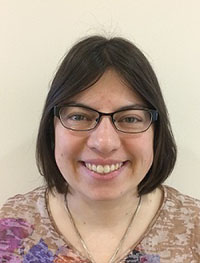Minnesota One Health Antibiotic Stewardship Collaborative (MOHASC)
- MOHASC Home
- About MOHASC
- News and Events
- Conferences and Presentations
- Honor Roll
- Stories
- Resources and Print Materials
- Contact Us
Related Topics
Contact Info
One Health Antibiotic Stewardship

Melissa Anacker, PhD: Stories of Antibiotic Use and Resistance
Research Scientist;
Minnesota Department of Health – Public Health Laboratory
As a public health research scientist focusing on antibiotic resistance, my work does not directly involve antibiotic use. However, the antibiotic-resistant microbes [microorganisms that can cause disease] submitted to my lab on a daily basis are studied to define antibiotic resistance trends. This research, in turn, sheds light on the global impact of improper antibiotic use. Additionally, tracking these trends allows us to respond to outbreaks of antibiotic-resistant microbes and educate health care facilities in regards to best infection control practices and proper therapeutic options.
I would say that one of the most challenging aspects of proper antibiotic use and stewardship is buy-in from all parties involved. Some examples include: patients requesting antibiotics for a viral infection, medical professionals improperly dispensing antibiotics, health care facilities that feel stewardship is too costly, farmers providing antibiotics to their livestock to promote growth, and the antibiotics that wind up in the environment as the result of improper disposal. Everyone needs to be willing to do their part and become a steward of antibiotics. The other major challenge is lack of public education on this topic. While there is more information out there about the dangers of antibiotic misuse and proper antibiotic use these days, the scientific community could do more to make sure this vital information reaches everyone involved.
My work at the Minnesota Department of Health-Public Health Lab focuses on tracking and characterizing antibiotic-resistant microbes submitted by Minnesota health care facilities and eight other states in the region, so I see very resistant microbes on a daily basis. The public health lab, in close partnership with epidemiologists, conducts statewide surveillance to determine the burden of antibiotic-resistant microbes in Minnesota and identify potential outbreaks early on in order to ensure proper infection control measures are in place so that these organisms do not spread further. In addition to looking for the current, common methods of antibiotic resistance, we employ testing methods that could enable us to discover novel [new] or emerging mechanisms of antibiotic resistance.
It is known that antibiotic use promotes antibiotic resistance and there has definitely been a global increase in the spread of emerging antibiotic-resistant microbes over the past decade. As a result, my work with antibiotic-resistant microbes has expanded in the past few years as new initiatives are put in place to better track this growing threat. One prime example is the Antibiotic Resistant Laboratory Network (ARLN) program established by the CDC (Centers for Disease Control and Prevention) in 2016. This initiative expanded laboratory capacity for tracking and characterizing antibiotic-resistant microbes to all fifty U.S. states and designated seven regional laboratories (of which my lab is one) to serve as subject matter experts for unusual cases of antibiotic resistance. Because of our role as a regional laboratory, I see more interesting resistant microbes from a regional perspective, as well as a broader view of antibiotic resistance due to the volume of specimens my laboratory receives. As more facilities are beginning to actively look for and report resistant microbes, we are able to see the evolving picture of antibiotic resistance both in the community and on a global scale.
I am concerned that, even with the available evidence and educational outreach that is being done, people will continue to behave as they always have, whether it is the patient demanding an antibiotic for a viral infection or the doctor prescribing that antibiotic even though it will not have an effect on the patient’s illness. Additionally, the antibiotic pipeline has slowed significantly and microbes are becoming resistant to antibiotics that have just been released for medical use, so even the new tools are not the solution to the antibiotic resistance problem. I feel that public education and changing the global attitude toward antibiotic use will be our most valuable tool in the fight against antibiotic resistance.
For antimicrobial resistance, I would like to know what the next emerging resistant microbe on the horizon will be and how we can best combat it before it widely spreads. For antibiotic use, I would like to know more about exactly where antibiotic misuse is happening and how we can better promote antibiotic stewardship as a positive and necessary step in the fight against antibiotic resistance.
Last Updated: 10/20/2022